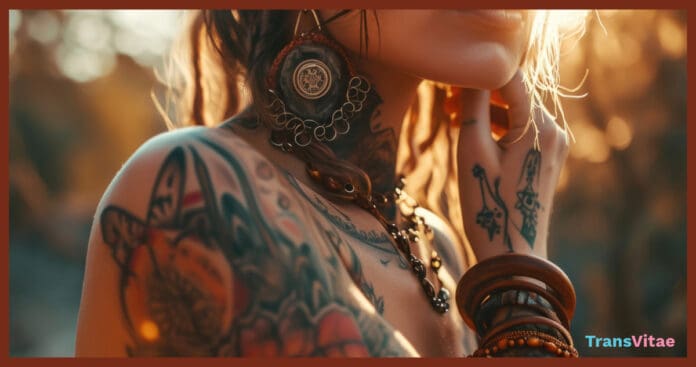Scars carry stories. Some of the engravings were the result of accident, while others were the result of a surgeon’s deft hand. In the world of tattoos and body modification, these scars become opportunities for self-expression, healing, and, for the transgender community, a chance to reclaim their bodies on their own terms.
When the Body is a Battleground
“My body felt like a warzone I never signed up for,” says Alex, a trans man who sports a vibrant chest tattoo covering his top surgery scars. Many trans people, like Alex, experience dysphoria, a profound mismatch between their assigned sex at birth and their gender identity. The physical body can become a source of pain and alienation, making tattoos and body modification tools for self-transformation.
From bold mastectomy tattoos that transform surgical scars into sprawling wings or blossoming flowers, to the subtly powerful affirmation of a name tattooed in a person’s chosen script, body art allows trans folks to redefine what their bodies mean to them.
“It’s not about hiding the scars,” explains Riley, a nonbinary tattoo artist specializing in scar camouflage. “It’s about making them part of a story you control, a design that reflects who you are inside.”
The Ink and Needle as Tools of Empowerment
We spoke to Jules, a trans woman who found solace in piercings and stretchings when her body was changing. “Hormone replacement therapy changes your flesh. The stretchings helped me feel in tune with that change. It was like actively choosing how my body morphed, one gauge at a time.”
Transgender-led tattoo studios and body modification spaces are popping up across the country, understanding the need for safe, affirming spaces. These aren’t just about the art itself, but about building community, sharing stories, and celebrating the full spectrum of trans embodiment.
Healing Beyond Ink
Scars, whether physical or emotional, can linger long after transition. For some people, the permanence that tattoos or other body modifications offer can be incredibly comforting. It’s a way of declaring, “This body is mine, and I define its beauty and its power.”
Of course, tattoos and body mods aren’t the only route. The journey towards body acceptance is unique for every trans person. What this trend represents is choice; the power to claim your body as your own canvas, however you choose to decorate it.
Pushing Boundaries: Scarification and Beyond
Body modification has existed outside of mainstream Western society for millennia. Scarification, the intentional creation of raised scars in patterns, is seeing a resurgence within the trans community. It offers a rawness and directness that appeals to those looking for a less traditional form of body art.
“Scarification gave me back a sense of my body’s strength,” says Kai, a transmasculine person who bears intricate scar work tracing their body. “It’s a reclamation, a ritualistic act of taking ownership over how my skin tells my story.”
The Power of Visibility
Transgender bodies are often subject to scrutiny and erasure. Tattooing and body modification allow individuals to reclaim that narrative, celebrating their journeys on their own terms. By proudly displaying their art, they challenge societal norms around what bodies should look like, opening up conversations about gender diversity and self-determination.
Body art and personal style are about so much more than aesthetics. For the transgender community, they represent a vibrant toolkit for transformation. It’s a testament to human resilience, a celebration of identity, and a bold declaration that trans bodies are beautiful, in all their unique forms.
Please Note: It’s important to consult with medical professionals before seeking tattoos or body modifications, especially if you have a history of certain health conditions.


